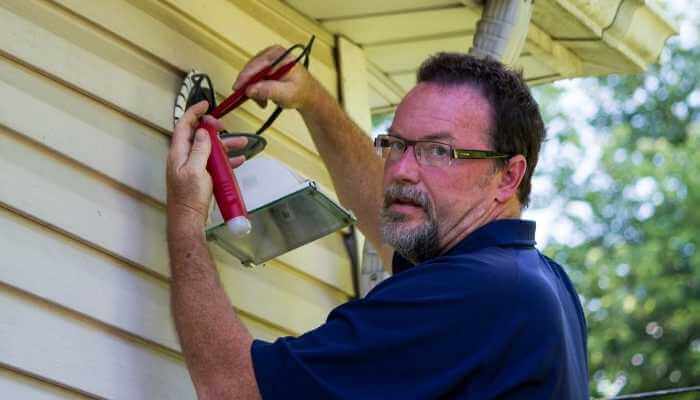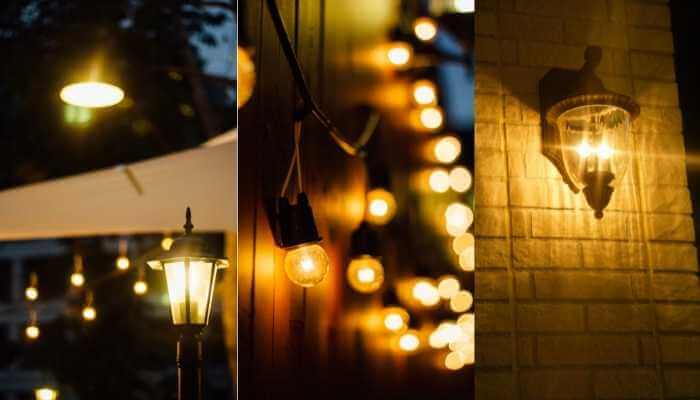When it comes to installing exterior lighting, there are a lot of questions raised surrounding electricity. None are so prevalent or important as understanding grounding.
Every light fixture that you install, whether inside or out, should be properly grounded. There are very few exceptions. Landscape lighting may not use a lot of electricity, but without proper ground, it can still shock and blow circuits, causing damage. So it’s best to know about your grounding.
Not all of us are electricians and even fewer of us know one thing at all about installing lights. But here we are, looking at those DIY kits for landscaping lights or for a security lamp in front of our car, or a replacement wall sconce near our door. And we’re lost.
No worries! Keep reading for things you need to know about these projects and my recommendations.
Do Landscape Lights Use a Lot of Electricity?
Not really. Your transformer can be left on at all times while the lights themselves only come on and are adjusted using a remote, switch, or app. The transformer doesn’t consume energy until the lights are on. And your manufacturing quality also counts when it comes to energy consumption. Higher quality will often use less energy, even at a higher wattage than a lower quality unit.
From what I found out, a standard 12 – 20 light system will use less energy than today’s modern television. And get this – it uses only a fraction of the energy that a modern home theatre system uses. Although no two systems are the same, on average running a standard 12 – 20 light system will cost 10¢ – 13¢ per night. So that’s less than $50 per year.
Do Outdoor Lights Need to Be Grounded?
So let’s get into the main question. What exactly is grounding? Well, it’s the process of transferring excess electricity to a material that can infinitely absorb an electrical charge through low resistance wires. It allows things like surges to be absorbed by something rather than allowing it to become an electrical fire hazard.
Grounded wiring makes your electrical circuits safer, more efficient, and more stable. It keeps your electrical products from being destroyed in any sort of power surge and also deviates the extra electrical charge into the absorbing material instead of pushing it out to ignite.
Now, it’s true, that for fixtures that have 100% plastic fittings, you can bypass grounding. However, I’m not one that would be willing to take that risk. Some fixtures can have part plastic and part metal fittings and they aren’t always easy to discern.
Ideally, any fixture that needs to be grounded will have instructions written out plainly in the packaging for it and most also have the wires and screws needed for it. This is why I prefer to pass the installation to a professional electrician.
Do Outdoor Lights Need to Be GFCI Protected?
GFCI stands for Ground Fault Circuit Interrupter. If the flow of electricity suddenly goes to the ground, that means there is an excess of electricity on the circuit. And therefore the GFCI will interrupt the circuit. If your lights are not connected by internal wiring, then yes, they should be plugged into GFCI-protected receptacles.
The normal requirement is to have at least one GFCI receptacle at the front of your house and at the back of your house. They can be no higher than 6 feet, 6 inches (198 centimeters / nearly 2 meters) from the ground.
The reason this is important is that GFCI receptacles are made to trip when an electrical current is too high. It’s a circuit breaker for that particular location. They are made to be around water or wet areas.
You should be sure that any lighting fixtures, light bulbs, and extension cords you use are rated for outdoor use. Make sure the connections are protected and waterproofed.
How Do I Know If an Outdoor Light Is Grounded?
In a newer house or a house that has had a wiring update, all house wiring, including most outdoor lighting, will have three wires inside – white, black, and ground. So you can just open up the fixture base and see if there is a third wire that is the ground. Most newer fixtures have a copper or green wire for the ground.
If you’re not sure or if the wiring is older, You can tell by using a circuit tester or a non-contact voltage tester. I can take you through the steps of testing if an outdoor light is grounded, however, my recommendation is to hire a professional. They can do it faster, have more experience, and can handle these things much more safely than most homeowners.
For testing, you have to access the wires while the fixture has power running to it and the light is on. I find this works best with a partner. Just unscrew the fixture enough to expose the wires. While your partner is holding the fixture, find the black (hot) wire using a non-contact voltage tester. Next, using a circuit tester, touch one end to the black wire and the other to the box.
If the fixture is grounded, the light on the tester will light up.
Remember, if there is any metal at all in a light fixture outside, it should be grounded. Otherwise, when it gets wet and there is a power surge (and you get power surges feasibly when the power has gone down and then suddenly comes back on after the outage), the circuit the fixture is attached to will be blown and all devices attached can take the surge. Worst-case scenario, someone who is wet touches the metal fixture and gets a shock.
How Does One Ground an Outdoor Light?
Well, most commonly, you would just follow the instructions on your packaging or inside the packaging of your new light fixture. But, I asked the hubs and we can provide you with the basic steps. Keep in mind, that we do not do this. We hire electricians.
As I said above, there should be three wires on the fixture: black, white, and green (or copper). Make sure the correct circuit breaker is off and your wiring is not live (use a non-contact voltage tester to be sure). Have a partner hold the new light fixture for you. The wires coming from the house or base should also be black, white, and green (or copper).
Match the green/copper wires from the fixture to the base and twist them together using an electrical twisting cap. Then, match the other wires with their corresponding colors and do the same. Once the wires are tucked into the base, the fixture can be attached and you should be done.
The ground wires simply have to meet. If the ground was originally attached to the box, you could also do that. But I would check to be sure that the metal box is actually grounded before doing so.
In my opinion, if you’re dealing with an older house and things aren’t this straightforward, I think you should call on a licensed and insured electrician.
I’m including a really nice video from FIX IT Home Improvement Channel that very clearly walks you through the steps of checking for grounding and also installing a fixture when there is no ground wire available.
Should You Hire an Electrician?
Electricity is dangerous. My husband originally trained to be an electrical engineer. And even he prefers to hire a licensed and insured electrician to handle our wiring and installation needs. I believe in letting the pros handle these types of projects. So, yes, my opinion is that you should know what you want, maybe even have the correct products in hand then pass it off to an electrician.
I have provided the steps for these projects, but I always highly recommend using a professional. The good thing about reading the steps is that now you know how much trouble an electrician has to go through to handle the wiring in your house and outside.
I hope you learned a lot and some of your questions were answered. If you are interested in finding out the best lighting types for your outdoor projects, check out this article.













